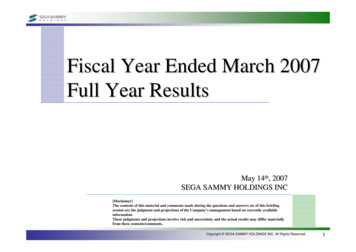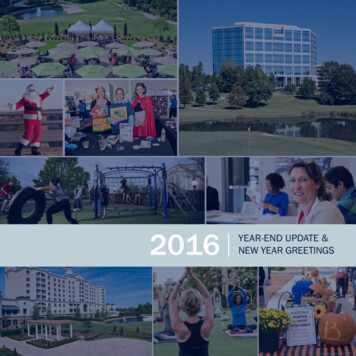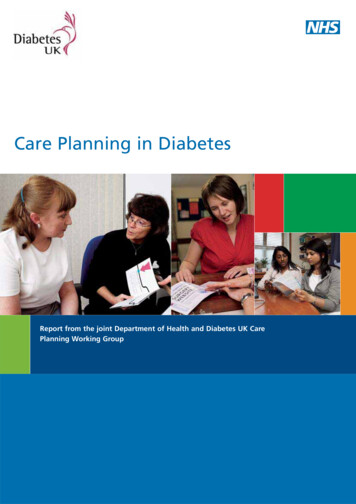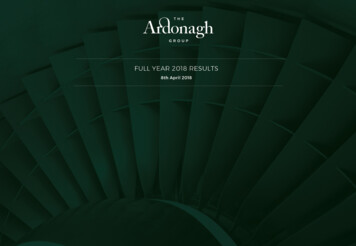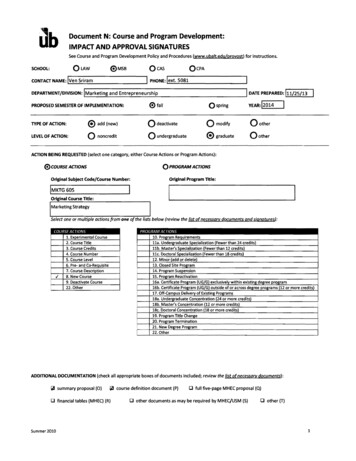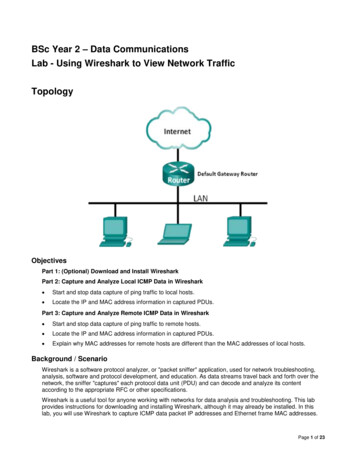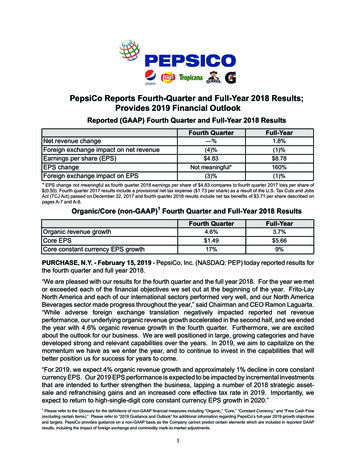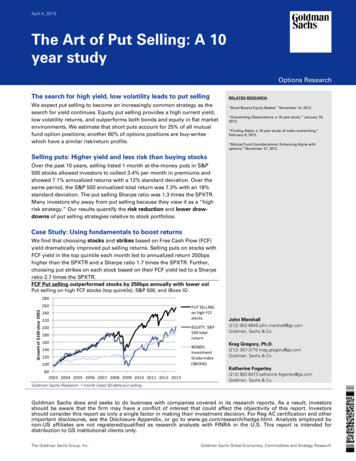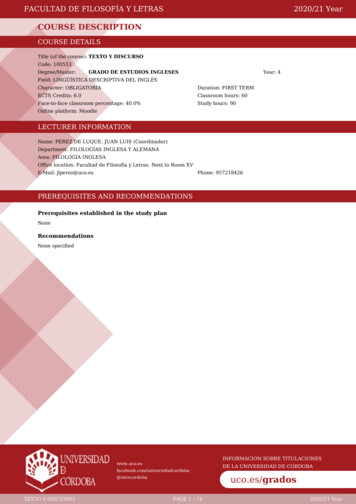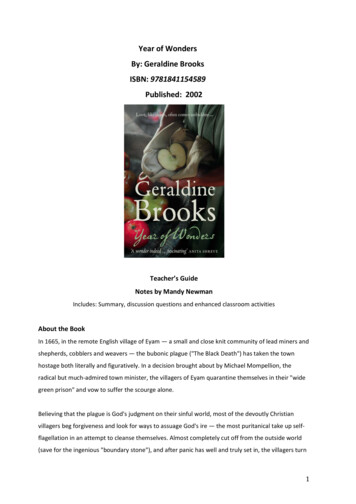
Transcription
Year of WondersBy: Geraldine BrooksISBN: 9781841154589Published: 2002Teacher’s GuideNotes by Mandy NewmanIncludes: Summary, discussion questions and enhanced classroom activitiesAbout the BookIn 1665, in the remote English village of Eyam — a small and close knit community of lead miners andshepherds, cobblers and weavers — the bubonic plague ("The Black Death") has taken the townhostage both literally and figuratively. In a decision brought about by Michael Mompellion, theradical but much-admired town minister, the villagers of Eyam quarantine themselves in their "widegreen prison" and vow to suffer the scourge alone.Believing that the plague is God's judgment on their sinful world, most of the devoutly Christianvillagers beg forgiveness and look for ways to assuage God's ire — the most puritanical take up selfflagellation in an attempt to cleanse themselves. Almost completely cut off from the outside world(save for the ingenious "boundary stone"), and after panic has well and truly set in, the villagers turn1
on one another. In episodes that illustrate both the best of human nature (ministering to the sick)and the worst (a gravedigger profiteering from the dead), the townspeople grapple with their griefand fear. It is up to the story's heroine — a young, widowed housemaid named Anna Frith — to raisethe existential questions about the origins of the plague, and she therefore becomes theembodiment of the conflict at the center of the novel: God versus Nature.O let it be enough what thou hast done,When spotted deaths ran arm'd through every street,With poison'd darts, which not the good could shun,The speedy could outfly, or valiant meet.The living few, and frequent funerals then,Proclaim'd thy wrath on this forsaken place:And now those few who are return'd agenThy searching judgments to their dwellings trace.- From //Annus Mirabilis, The Year of Wonders, 1666// by John DrydenAbout the authorGeraldine Brooks is one of Australia’s greatest authors. She is the author of the Pulitzer Prize-winningMarch, Year of Wonders, People of the Book and Caleb’s Crossing and the non-fiction works NineParts of Desire and Foreign Correspondence. Previously, Brooks was a correspondent for the WallStreet Journal in Bosnia, Somalia, and the Middle East. Born and raised in Australia, she divides hertime between Sydney and Martha’s Vineyard, Massachusetts. She lives with her husband, the authorTony Horwitz, and their two sons, Nathaniel and Bizuayehu.You can visit her website at: http://www.geraldinebrooks.comTo the TeacherThese notes and activities are generally suited to students in years 10-12 but could be used morewidely. Please select and adapt according to your students’ needs. Some websites have been linkedto these classroom activities, but your school library or public library will have wonderful resources,too. Help students develop their information literacy skills by discussing other possiblesources/places to access information.2
Pre-reading activitiesThe 1600s were a torrid, violent time. The period was marked both the dawn of modern medicineand the beginning of the Age of Enlightenment all over Europe. In England, these years also broughtthe Restoration - http://www.bbc.co.uk/programmes/p00547bx—a revolution in every aspect of lifeagainst Cromwell’s Puritanism - well.htm.English physicians charted the circulatory system, and the invention of the compound microscopeand identification of bacteria were together about to begin unravelling the mystery of infectiousdisease.In 1662, King Charles established the Royal Society -http://royalsociety.org/aboutus/history/?from welcome in order to promote the study of natural science. The world was changingrapidly, and its central focus shifted from God to man. Women, who had always had a role in healingand medicine, were excluded from the study of medicine, yet continued to provide a range of paidhealing services such as midwifery and wet nursing. The 1660s were a particularly savage time.England was ravaged by the Black Death in 1665 and London was razed in the Great Fire of London in1666. Life was fragile. Death imminent.1. Discuss or brainstorm students’ prior knowledge of the time in which the book is set.To assist discussion, you could play some of the Horrible History videos:The Plague songhttp://www.youtube.com/watch?v SklcFeh6AiEEnglish civil warhttp://www.youtube.com/watch?v O4b0G auKCIOliver Cromwellhttp://www.youtube.com/watch?v vWPbnWMpMiA&feature relatedMonty Python on Oliver Cromwellhttp://www.youtube.com/watch?v DJ1yPz14LrUQuestions to encourage discussion:The Plague – what it was, how many people died?What was life like in England in 1665?Who was Oliver Cromwell?Who were the Puritans and what did they believe in?What was the Restoration? Were there doctors or healers at this time?3
What was the role of science at this time?What was the relationship between God and men and women?Do you think that people are inherently good or evil?Should people act in the interests of themselves as individuals or for the good of theircommunity?Looking at the cover of the book, what do you think it is about? Does it remind you of anyother books you have read?2. Research and presentation activitySet students the following research topics. Divide the class into pairs or small groups and assign onetopic per pair/group. Ask them to research a list of questions and then to prepare a five minutePowerpoint/Prezi presentation or poster/glogster on the topic. Class members listen and write downthe key points in their notebooks so you can check to make sure they have taken down the notes!Please see Attachment One for research prompts that could be used in class.The Plague of 1665What was it?How many people died?How was it transmitted?What happened to people who got it?What did people do to try and prevent its spread?Oliver Cromwell and PuritanismWho was Oliver Cromwell and what did he do?What was Puritanism? Why was it significant?What changed in English society as a result?Was Christmas celebrated and were theatres closed during this period?The RestorationWhat was it?What were the key events?What happened as a result? Why was it significant?What changed in English society as a result?4
The role of women in medicine in EnglandWhat was the Age of Enlightenment?What did it mean for women?What kind of roles had women played in healing and medicine?Were women excluded from medical studies? What happened as a result?Year of Wonders is based on a true storyYear of Wonders is based on a true story about how the Plague affected the villagers of Eyam – asmall village in the middle of England in 1665. It is a fictionalised account of a historical event. Over aperiod of 14 months, 274 people died out of a total of 350 people.In early September 1665, the local tailor, George Viccars, died of bubonic plague. It is believed thathe bought the disease to the village with a bolt of cloth. Over the following weeks other members ofthe village succumbed to the disease. To prevent the disease spreading to other villages the localrector, William Mompesson convinced the people of Eyam to quarantine themselves within thevillage boundary. A few inhabitants fled, but most stayed. There is a museum in Eyam whichcontains detailed displays and accounts of when the village went into voluntary quarantine when"The Plague" was imported in infected cloth from London in 1665.Geraldine Brooks — author of Year of WondersGeraldine Brooks chanced upon the story of Eyam and its terrible history while living in England in1990.“The written record of what happened in Eyam during the plague year is scant. Apartfrom three letters by the rector, no narrative account from the year itself actually exists. The"histories" that purport to record the facts were actually written many years later, andhistorians have found inconsistencies that cast doubt on their accuracy. Therefore, there wasno way to write a satisfying nonfiction narrative. And, since the story had taken root in myimagination, the only way to indulge my impulse to tell it was to take the leap into fiction.The factual basis of the story was actually very helpful to me: it was like having the framing ofthe house already erected — I could see the shape from the r/authorExtra.aspx?authorID 50017902&displayType interview5
Reading the storyThe first pageLook at the extract from Annus Mirabilis on the first page. Define Annus Mirabilis. What happened in1666? Why is the poem called Year of Wonders?O let it be enough what thou hast done,When spotted deaths ran arm'd through every street,With poison'd darts, which not the good could shun,The speedy could outfly, or valiant meet.The living few, and frequent funerals then,Proclaim'd thy wrath on this forsaken place:And now those few who are return'd agenThy searching judgments to their dwellings trace.- From //Annus Mirabilis, The Year of Wonders, 1666// by John DrydenPlay the students the video of the Queen’s Speech in 1992http://www.youtube.com/watch?v dHlEzh5ky1ARead out and examine this extract from the Queen’s speech:“1992 is not a year on which I shall look back with undiluted pleasure. In the wordsof one of my more sympathetic correspondents, it has turned out to be an 'Annus Horribilis'.I suspect that I am not alone in thinking it so. Indeed, I suspect that there are very few peopleor institutions unaffected by these last months of worldwide turmoil and uncertainty. Thisgenerosity and whole-hearted kindness of the Corporation of the City to Prince Philip and mewould be welcome at any time, but at this particular moment, in the aftermath of Friday'stragic fire at Windsor, it is especially so.”What happened to the Queen and the Royal Family and England in 1992?Why did she refer to it as Annus Horribilis?Think about a year in your lives.Has there been one year that was the best year of your life? What happened? Did you get abike or move to a house with a swimming pool? Did your Mother have a new baby?Or, have you ever had a really terrible year, with a Grandparent or beloved pet dying?6
Looking back is there any part of that terrible year that turned out to be a positive? Did youlearn something about yourself that you didn’t know? Did you become closer to someonewho proved to be a dear friend?Chapter One – Apple picking timeWhy is this chapter called Apple-picking Time?What part of the story does this chapter discuss?It is at the beginning or near the end of the story?Who is the narrator? What has happened to her husband? What impression do you get ofwhat she thinks about her husband?What is the relationship between the narrator and the Rector?What does Anna think about Mrs Mompellion? Are they good friends or enemies? Whatmakes you think that?Why is Anna so kind to the horse?Chapter Two – Ring of RosesWhat does the title mean? What kind of clue does this give the reader as to what is tofollow?Who is George Vickers and what is his occupation?What does George bring into Anna’s life?Can you see a change in Anna with the arrival of George into her home?Describe what Elinor Mompellion looks like when Anna first sees her.What do we learn about herb knowledge? What does Anna think happens to women whopartake in it?What role does Mem Gowdie play in the village?Describe what happens to George Vickers – what happens to his face and body?What impression do you have of the Rector and his horse?Chapter Three - The Thunder of His VoiceWhat does the title mean? Whose voice does it refer to?What does Anys do? How does she help the villagers?Describe and draw a picture of the Gowdies’ cottage and garden.How did you feel when you read of what George’s intentions were for Anna? If you felt sadfor her, why?Why does Anys not want to marry?7
What did the Puritans consider to be dark and light?Is Anys good or bad?When is the Plague first mentioned?What is the Rector’s response to the idea of running from the Plague? What role does Godplay in his belief? Would you run from the plague?How would you describe Anna? Is she forthright or docile?Chapter Four - Rat-fallWhat does the title mean?Describe how Anna feels about her children on pages 66 and 67.Why has the author written about the children so tenderly?What do you think is going to happen?What does Mem think of the barber-surgeon?Does the barber-surgeon provide relief for Edward?Does Anna do something that she hasn’t done before?What happens to Tom?How did you feel reading about what happened to Tom? Why?Chapter Five – Sign of a WitchWhat does the title suggest is going to happen?Who manages to provide relief to Jamie?What does Anna think about Anys Gowdie’s herbal remedies? Do you think she is beginningto question the existence of God?How did you feel when Jamie died? Describe in detail his final day. What has the author doneto make you feel sad when Jamie dies?Do you agree “in the midst of life, we are in Death?”Does Anna defend Mem? Why does she come to her aid?Were the villagers justified in their belief that the Gowdies are witches?What does the Rector do? Why is he called Michael Mompellion in the last pages of thischapter?Who is right and who is wrong?What is the significance of the last sentence?Chapter Six – Venom in the BloodWhat is the snow a metaphor for?What does the village lose when Mem and Anys are gone?8
Why do you think the Rector suggests that this is the time to quarantine themselves?What role does the killing of Anys have? What arguments does he present?What role does Mr Stanley have in persuading the villagers?Why do the Bradford’s depart?Why does Anna decide to stay?Why do the villagers listen to the Rector?Chapter Seven - Wide Green PrisonWhat arguments does the Rector put forward for the Bradford’s to stay?What does Colonel Bradford argue?What does Anna think? Why does she stay?Why is the Rector so furious with the actions of the Bradford family when they decide toleave
About the Book In 1665, in the remote English village of Eyam — a small and close knit community of lead miners and shepherds, cobblers and weavers — the bubonic plague ("The Black Death") has taken the town hostage both literally and figuratively. In a decision brought about by Michael Mompellion, the radical but much-admired town minister, the villagers of Eyam quarantine themselves in .File Size: 805KBPage Count: 19
